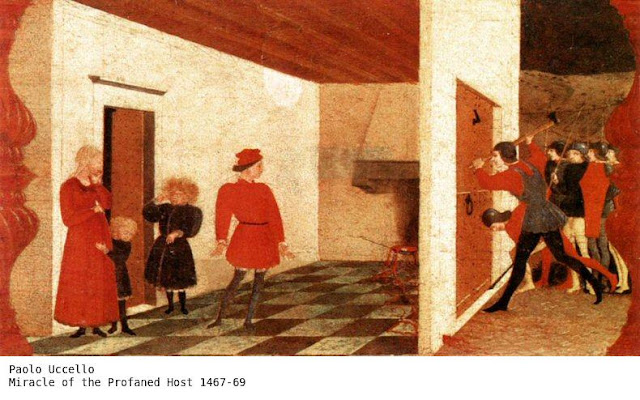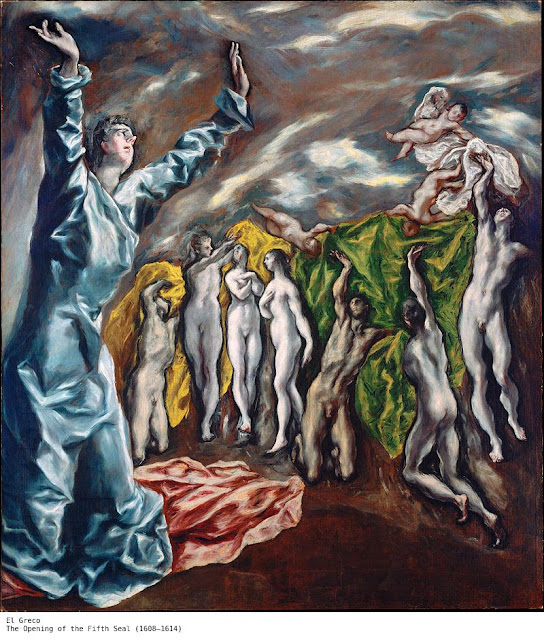 |
| See http://dev3.cepr.org/meets/wkcn/1/1714/papers/Malanima.pdf |
It is difficult to estimate GDP across a millennium but there is fairly general agreement that much of Europe had a mini boom in the 15th C. In England the effect of the Black Death was reinforced by the end of the Wars of the Roses.
It was remarkable that Italy enjoyed any prosperity at all because it was the battlefield between France, Spain, the Holy Roman and the Byzantine Empire during the middle ages. In AD1000 Italy was where the Holy Roman and Byzantine Empires met:
By the fifteenth and sixteenth centuries many of the northern states had managed to exploit the enmity between the Great Powers to obtain a precarious independence and even substantial international power.
As was later the case when the Netherlands freed itself from being part of a European megastate, the new freedom led to a cultural renaissance.
According to Art Historians such as EH Gombrich the Renaissance in the visual arts began in 15th century Florence with the work of the sculptor Donatello, the architect Filippo Brunelleschi (1377-1446) and the artist Masaccio. The new art was heavily influenced by the International Gothic style that had swept northern Europe and by the newly emerging Flemish painting (the work of Van Eyck was known to the Italians – he is mentioned as a significant artist by the antiquarian Ciriaco de' Pizzicolli in 1449) . However, it was the systematic use of perspective that was hallmark of the Renaissance in art.
Brunelleschi is important because he introduced the mathematics of perspective to art.
The idea of perspective is to produce an image that is similar to that produced on the retina of the eye. Perspective painting was rapidly adopted by Florentine artists.
In the early fifteenth century many artists combined elements of the International Gothic style with the new Renaissance approch. This is particularly clear in the work of Uccello.
Paolo Uccello, born Paolo di Dono 1397-1475
Uccello's “Battle of San Romano” was a triptych commissioned by the Florentine Bartolini Salimbeni family.
Although it has some elements of perspective, such as the space created by the parallel, broken lances in the foreground the picture has a gothic style.
Uccello became deeply interested in the new techniques of perpective painting and there are several extant sketches showing his geometrical approach.
Uccello often provides a Renaissance stage for pre-renaissance content:
“The second panel of Paolo Uccello's Miracle of the Profaned Host from the Urbino Confraternity of Corpus Domini predella. A Jewish moneylender is cooking the host, which emanates blood. The Jew's wife, her unborn child, and her children look on in terror as the blood pours into the street in rivers while soldiers break through the door. The painting is structured around the Golden Section.” (Wikipedia)
The influence of Van Eyck
Van Eyck was an important influence on Renaissance painting, for instance in 1454 he was named as the greatest artist of his day in a biography by the Genoese author Bartolomeo Facio (In his "De viris illustribus"). Van Eyck's contribution was the use of oils and his portrayal of fine, life-like detail. Van Eyck was even, mistakenly, believed to have invented oil painting.
The Arnolfini portrait above demonstrates an instinctive use of perspective but Van Eyck did not use the mathematical perspective that was the hallmark of Renaissance painting:
Sandro Botticelli (1446 – 1510)
Botticelli is another Florentine artist who was enthused by the new approach to art. Despite this he still owes a great deal to Gothic art, especially in the flowing form of his figures. He adopted the use of oils as they were introduced from northern Europe and this allowed him to produce brightly coloured work.
Botticelli is truly a pre-Raphaelite artist – Burne Jones would have been proud of the five angels in his picture “The Virgin and Child Surrounded by Five Angels”
Botticelli was patronised by the famous Medici family in Florence. The Birth of Venus was commissioned by Lorenzo di Pierfrancesco de Medici
Although much later than the Virgin and Child shown previously it was painted using the old technique of egg tempera rather than oils. Much has been written about this painting extolling its beauty. To a modern sensibility it looks a bit like a soap advert, which, perhaps, shows how influential it has been in forming western aesthetics. The proportions of the left arm and shoulder and the neck suggest that Botticelli still enjoyed the freedom of Gothic representation in a Renaissance setting. The Medici's probably commissioned the painting both for its erotic content and to show how they believed that Italy was becoming the Classical World reborn.
Leonardo da Vinci (1452-1519)
Much has been written about Leonardo da Vinci and, because his interests spanned arts, engineering and science he is the archetypal “Renaissance Man”. During his lifetime he painted very few major artworks and only about fifteen of these have have survived. However, he produced thousands of drawings and these constitute a huge body of artistic work.
His major contribution was to advance the understanding of anatomy amongst artists. His anatomical knowledge stemmed largely from studies of corpses.
The influence of his anatomical studies on his art can be seen clearly in one of his earliest, unfinished paintings, St Jerome in the Wilderness (1480):
As might be expected from someone with a keen interest in mathematics and engineering, his pictures contain the new knowledge of perspective.
One of his most accomplished pictures, Lady with an Ermine, was commissioned by Ludovico Sforza, the Duke of Milan and showed his mistress, Cecilia Gallerani.
Notice that Leonardo has even portayed the musculature of the Ermine. The picture raises several questions such as how far “gothic” style was also a style amongst the people – Cecilia is pale and has a languid appearance. Also, were here fingers really that long? Leonardo portrayed his subjects as people with real character. The Mona Lisa is the most famous example of this aspect of his painting but the Lady with an Ermine, for all her smooth beauty is also looking dubiously wistful.
Raphael Santi (1483-1520) (born: Raffaello Sanzio da Urbino )
Raphael was born in Urbino in Umbria and started his artistic career in the workshop of Pietro Perugino. Perugino's workshop produced many religious paintings where the message was more important than the realism of the content. He moved to Florence and was exposed to the work of masters such as Da Vinci and Michelangelo.
Raphael moved Renaissance art from a pursuit of reality to a representation of ideals, especially ideals of beauty.
He was responsible for countless Madonna and Child representations.
Raphael also mastered the grand, imaginary composition.
Antonio Allegri (1489?-1534) “Correggio”
Correggio gained his nickname from the town of Correggio where he was born. He spent much of his working life in Parma in Northern Italy. He took Raphael's idealistic approach yet further and used light and dark and colour to enhance the depth and the focus of a painting.
Correggio's work was also distinctly Mannerist,
Domenico Theotocopoulos (1541-1614) “El Greco”
Perhaps the most extraordinary feature of the Renaissance is the way that there was an openness to styles of art that would be unacceptable for centuries afterwards. The work of El Greco falls into this category.
El Greco's work could be truly sublime as well as abstract:
The Early Renaissance masters.
Paolo Uccello (1397-1475) (born Paolo di Dono)
Andrea Mantegna (1431-1506)
Pierra della Francesca (1416? - 1492)
Sandro Botticelli (1446 – 1510)
Jean Fouquet (1420? - 1480?)
The Mainstream of Renaissance Art
Leonardo da Vinci (1452-1519)
Michelangelo Buonarroti (1475-1564)
Giovanni Bellini ()
Raphael Santi (1483-1520)
Antonio Allegri (1489?-1534) “Correggio”
Titian (1485? - 1576)
Hans Holbein the Younger (1497-1543)
Albrecht Durer (1471-1528)
Cranach
Jacopo Comin “Tintoretto” (1518-1594)
Domenico Theotocopoulos (1541-1614) “El Greco”
Paolo Uccello (1397-1475) (born Paolo di Dono)




















